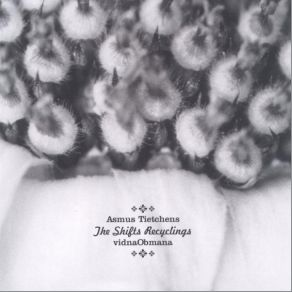The Shifts Recyclings
Download links and information about The Shifts Recyclings by Asmus Tietchens, Vidna Obmana. This album was released in 2002 and it belongs to Electronica, Avant Garde Jazz, Rock, Avant Garde Metal genres. It contains 12 tracks with total duration of 02:04:30 minutes.

|
|
|---|---|
| Artist: | Asmus Tietchens, Vidna Obmana |
| Release date: | 2002 |
| Genre: | Electronica, Avant Garde Jazz, Rock, Avant Garde Metal |
| Tracks: | 12 |
| Duration: | 02:04:30 |
| Buy it NOW at: | |
| Buy on iTunes $19.99 | |
| Buy on Songswave €3.50 | |
Tracks
[Edit]| No. | Title | Length |
|---|---|---|
| 1. | T3 : S 1/5 | 8:34 |
| 2. | T1 : S1/1 | 11:23 |
| 3. | T5 : S1/10 | 7:52 |
| 4. | T4 : S1/6 | 8:36 |
| 5. | T2B : S1/3 | 7:06 |
| 6. | T3B : B1/5 | 8:23 |
| 7. | I | 22:58 |
| 8. | II | 8:16 |
| 9. | III | 17:42 |
| 10. | IV | 7:07 |
| 11. | V | 9:14 |
| 12. | III (Reprise) | 7:19 |
Details
[Edit]One of the more intriguing collaborations in modern ambient music, The Shifts Recyclings is actually a three-way effort between Tietchens, Obmana, and Frans de Waard, working here under the Shifts guise. Shifts itself has recorded a number of efforts derived from creating ambient works via acoustic and electric guitar; the two other musicians contacted de Waard separately about the possibility of a remix collaboration, resulting in the two-disc effort. Both Tietchens and Obmana were given the same source material to work with, though otherwise they had no direct interaction, making Shifts Recyclings all the more of a balanced work. Tietchens' disc is the more overtly downcast of the two, in terms of emphasizing dark drones and subtle but harrowing instrumentation and production — the clattering guitar abuse as percussion on "T3B:S1/5" may be de Waard's straight up, but sounds thoroughly unnerving here. The way "T1:S1/1" combines a recurring rumble Thomas Köner might be proud of with a strange, plucked improvisation or the strange breathing/flange loop of "T4:S1/6" provides a watery centerpiece for an even more minimal arrangement also show what Tietchens is capable of creating. Obmana's disc in contrast to Tietchens — and perfectly in keeping with his own particular style — places the overall emphasis on vast swathes of echo and at-once soothing and bottomless sonic depths. Tietchens may suggest a crumbling haunted house, but Obmana paints a picture of an endless, vaulting cavern H. P. Lovecraft might be proud about. The lengthy "I" in particular, with its almost flute-like sounds weaving amidst the heavily treated guitar parts, and the almost as long "III," with a generally similar but more immediately active arrangement and what almost sounds like a string part toward the end, rank among his best here.